MSI GT70 Review: GTX 880M Edition
by Jarred Walton on April 16, 2014 6:00 AM ESTMSI GT70 GTX 880M Gaming Performance
We’re at the point now where the fastest mobile GPUs can run just about everything at maxed out settings. There are a few exceptions, e.g. Metro Last Light will need to drop a setting or two to stay above 30FPS at 1080p, but the GTX 880M – and even the previous generation GTX 780M – are fast enough that some games are running into CPU limitations. That’s not really a problem in practice, since games that are CPU limited tend to still hit 60+ FPS, and if you’re running at lower detail settings just to show CPU bottlenecks it’s an artificial constraint.
Anyway, if you happen to have a system with a GTX 880M paired with an i7-4700MQ and you compare performance to a GTX 780M with an i7-4930XM, you’ll find instances where the faster CPU wins out. At our Mainstream and Enthusiast settings, however, all of the games we currently use for testing favor the faster GPU over a faster CPU. We’ve included results from some of the fastest notebooks we tested during the previous year for comparison. I’m only going to post charts of our Enthusiast settings, as anyone buying a notebook with a GTX 880M inherently qualifies as a gaming enthusiast in my book, but you can find the Mainstream and even Value scores in Mobile Bench (though the Value scores in particular are mostly meaningless).
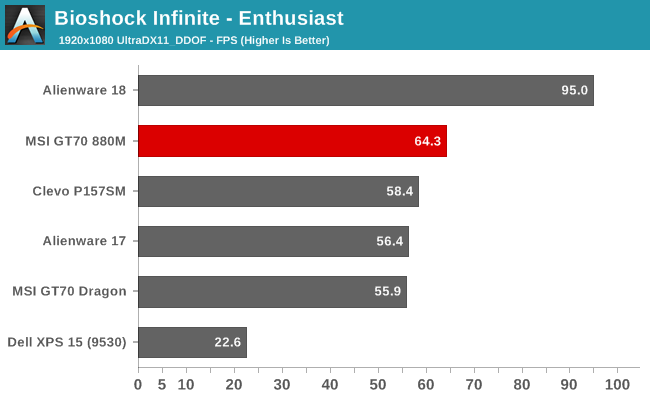
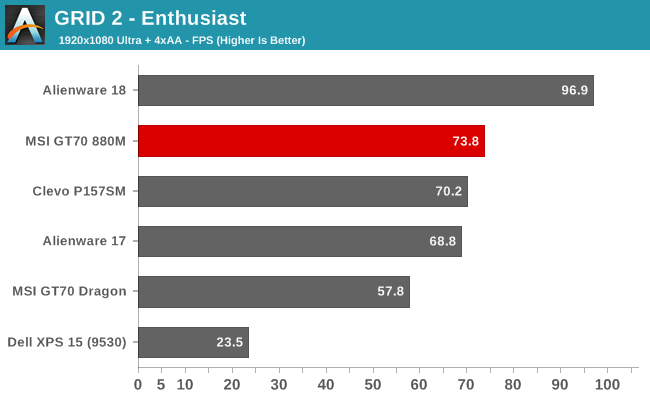
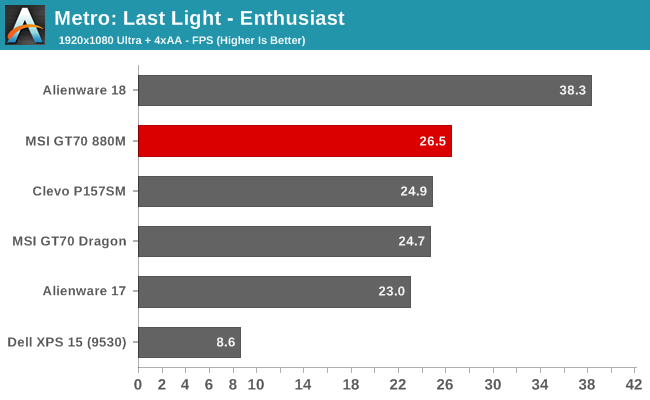
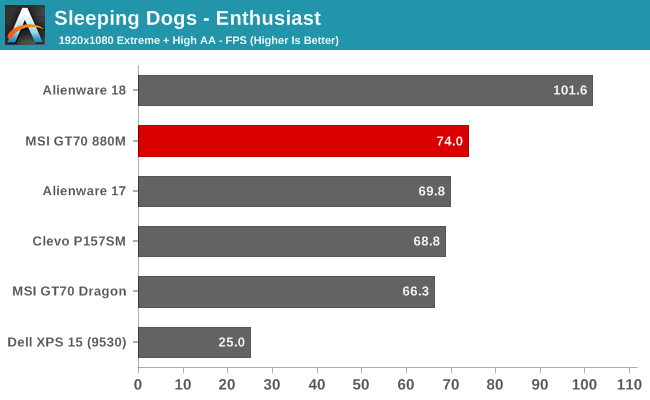
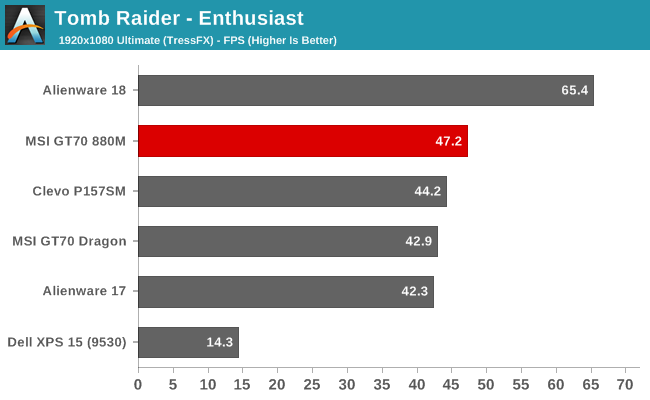
In their launch materials, NVIDIA claimed the new GTX 880M as being 15% faster than last year’s GTX 780M. Overall, our results with the GT70 compared to the Clevo P157SM or the previous GT70 Dragon don’t really agree with that figure, though it varies by game. It’s more accurate to state that the 880M is “up to 15% faster” rather than a 15% increase on average. The 880M boasts core clocks that are around 16% faster than the 780M, but memory bandwidth is the same so titles where the memory bandwidth comes into play (which is most games when we’re running at high/max details) will see quite a bit less than the maximum 16% increase in performance. The 880M does come with 8GB GDDR5 RAM, so there may be a few instances where the additional memory can help slightly, but right now most games are still targeting 4GB or less VRAM as the vast majority of GPUs shipped fall into that classification.
Overall, if we take the better result of the MSI GT70 Dragon and Clevo P157SM (on the assumption that driver differences may have negatively affected a few titles), the new GTX 880M ends up around 7% faster than the GTX 780M. It's not too surprising, considering we're looking at the same core architecture and the same memory bandwidth. 8GB VRAM is clearly more than the GTX 880M needs, at least with current titles; it might prove beneficial in the future, but I suspect by the time games are routinely using more than 4GB the 880M will be replaced by something newer/faster/better. While 7% isn't much of an improvement, keep in mind that the increase in cost (at least for an entire notebook) is only around $50. On an $1800 notebook that's a 3% increase, and considering the difficulty of acquiring a GPU upgrade for a notebook without buying a complete system, if you’re in the market for a gaming notebook the GT70 certainly offers a good value. If on the other hand you already own a gaming notebook with GTX 780M, you’ll likely want to wait for the inevitable “Big Maxwell” notebook GPUs to appear.










61 Comments
View All Comments
DanNeely - Thursday, April 17, 2014 - link
I have to disagree. The faster startup is nice; but it's the smoother response in ordinary use that's really sold me. Moving my OS/Apps to an SSD a few years ago did more to improve general system responsiveness than any upgrade I've made other than my initial move from a single to a dual core CPU.Notmyusualid - Monday, April 28, 2014 - link
I get chest-pains waiting on mechanical hard disks when used as a boot disk...My mother, and two of my brothers have switched over to SSDs, (at great effort by me), and they say they could never go back / transformed their machine etc. The third brother is too cheap to do so.
Now if you have the premium of time on your side, sure hitting the power button, and fetching coffee is fine.
But as a network engineer under the gun, when you have strict site-access periods, and it takes 2 weeks to get your access, and during your line-up testing, your in-house application crashes, and you've got only 30 mins before your escorted access ends, it is a God-send to be able to reboot quickly, start the database, and get your application up again, and continue to work with the other end of the link... I've known Core 2 Duo laptops, with mechanical disks, take 8 to 10 mins to do that task I just described. One minute thereabouts (honestly) with SSD. Marvelous. Surprised me too.
You can hear the deep breaths from the other end when you say 'sorry I have to reboot', but not a problem for me for a few years now...
So sorry, cannot agree there is little difference.
jak3676 - Wednesday, April 16, 2014 - link
Am I the only one that read the headline and was wondering why in the world someone would put an 8 year old 8800 GTX in a laptop?huaxshin - Wednesday, April 16, 2014 - link
@JarredWalton:From the summary, you wrote GK110 instead of GK104.
"As far as NVIDIA’s new GTX 880M, performance is pretty much what you’d expect from a slightly higher clocked GK110"
-----------------------------------------------------------------
Also did you notice that this particular model did much better than your previous GT70 review in terms of thermals? With the Dragon Edition you and me had a little discussion regarding the temperatures. You got 98C with that one while here you get 82C.
Any thoughts to why?
JarredWalton - Wednesday, April 16, 2014 - link
Possibly just a difference in components -- some 780M may run hotter (and with higher voltages) than this 880M. I pushed the system as hard as I could, just to see if it would throttle. Anyway, Dustin tested the earlier Dragon, so I don't know if he just had a poor unit or what. And I'll go edit that GK110 error. LOL -- GK110 in a notebook, I wish!shatteredx - Wednesday, April 16, 2014 - link
No 120hz display kills it for me. Does MSI even have any models with a 120hz display?Antronman - Wednesday, April 16, 2014 - link
Why would they?It's not like an 880m will reach 120fps in any games.
shatteredx - Thursday, April 17, 2014 - link
Any FPS above 60 will be smoother on a 120hz display.Also, I play many older games that hit 120 fps even on my 680M.
erple2 - Friday, April 18, 2014 - link
You need a couple of qualifiers on that. If you play with vsync on, it won't be any smoother. If you play with triple buffering, it will. Personally, I play with vsync on as I dislike tearing more than frame drops (though with proper triple buffering, you don't get the integer scaling in fps with no lag like d3d buffering offers). Though this seems like a great case for the highly proprietary g-sync..nathanddrews - Thursday, April 17, 2014 - link
Maybe not with all eye-candy maxed out, but that's not really the point of 120fps gaming.